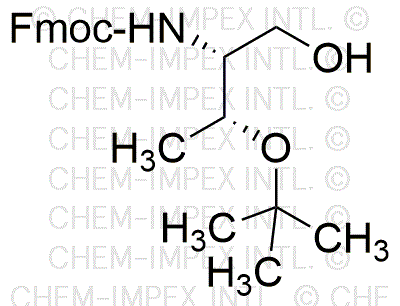Fmoc-O-tert-butyl-L-threoninol is widely utilized in research focused on:
- Peptide Synthesis: This compound serves as a protecting group in solid-phase peptide synthesis, allowing for the selective modification of amino acids. Its stability under various conditions makes it a preferred choice for chemists.
- Drug Development: In pharmaceutical research, it aids in the design of peptide-based drugs. The ability to easily remove the Fmoc group allows for the creation of active pharmaceutical ingredients with high purity.
- Bioconjugation: This chemical is used in the conjugation of peptides to other biomolecules, enhancing the delivery and efficacy of therapeutics in targeted drug delivery systems.
- Research in Protein Engineering: It plays a crucial role in modifying proteins for various applications, including enzyme engineering and the development of novel biomaterials.
- Academic Research: Its versatility makes it a valuable tool in academic laboratories for studying protein interactions and functions, contributing to advancements in biochemistry and molecular biology.
General Information
Properties
Safety and Regulations
Applications
Fmoc-O-tert-butyl-L-threoninol is widely utilized in research focused on:
- Peptide Synthesis: This compound serves as a protecting group in solid-phase peptide synthesis, allowing for the selective modification of amino acids. Its stability under various conditions makes it a preferred choice for chemists.
- Drug Development: In pharmaceutical research, it aids in the design of peptide-based drugs. The ability to easily remove the Fmoc group allows for the creation of active pharmaceutical ingredients with high purity.
- Bioconjugation: This chemical is used in the conjugation of peptides to other biomolecules, enhancing the delivery and efficacy of therapeutics in targeted drug delivery systems.
- Research in Protein Engineering: It plays a crucial role in modifying proteins for various applications, including enzyme engineering and the development of novel biomaterials.
- Academic Research: Its versatility makes it a valuable tool in academic laboratories for studying protein interactions and functions, contributing to advancements in biochemistry and molecular biology.
Documents
Safety Data Sheets (SDS)
The SDS provides comprehensive safety information on handling, storage, and disposal of the product.
Product Specification (PS)
The PS provides a comprehensive breakdown of the product’s properties, including chemical composition, physical state, purity, and storage requirements. It also details acceptable quality ranges and the product's intended applications.
Certificates of Analysis (COA)
Search for Certificates of Analysis (COA) by entering the products Lot Number. Lot and Batch Numbers can be found on a product’s label following the words ‘Lot’ or ‘Batch’.
Numéro de catalogue
Numéro de lot/série
Certificates Of Origin (COO)
This COO confirms the country where the product was manufactured, and also details the materials and components used in it and whether it is derived from natural, synthetic, or other specific sources. This certificate may be required for customs, trade, and regulatory compliance.
Numéro de catalogue
Numéro de lot/série
Safety Data Sheets (SDS)
The SDS provides comprehensive safety information on handling, storage, and disposal of the product.
DownloadProduct Specification (PS)
The PS provides a comprehensive breakdown of the product’s properties, including chemical composition, physical state, purity, and storage requirements. It also details acceptable quality ranges and the product's intended applications.
DownloadCertificates of Analysis (COA)
Search for Certificates of Analysis (COA) by entering the products Lot Number. Lot and Batch Numbers can be found on a product’s label following the words ‘Lot’ or ‘Batch’.
Numéro de catalogue
Numéro de lot/série
Certificates Of Origin (COO)
This COO confirms the country where the product was manufactured, and also details the materials and components used in it and whether it is derived from natural, synthetic, or other specific sources. This certificate may be required for customs, trade, and regulatory compliance.


